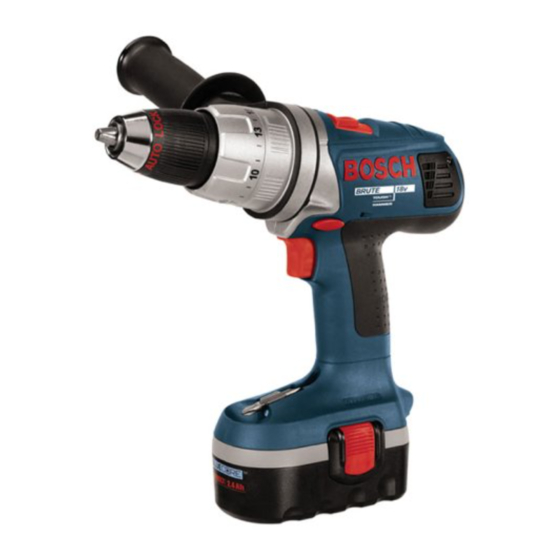Bosch 13624 Operating/Safety Instructions Manual - Page 3
Browse online or download pdf Operating/Safety Instructions Manual for Drill Bosch 13624. Bosch 13624 21 pages. Cordless hammer drills
Also for Bosch 13624: Operating/Safety Instructions Manual (41 pages)

chuck. If the bit is not inserted deep
enough, the grip of the jaws over the bit is
reduced and the loss of control is increased.
Do not use dull or damaged bits and
accessories. Dull or damaged bits have a
greater tendency to bind in the workpiece.
When removing the bit from the tool avoid
contact with skin and use proper
protective gloves when grasping the bit or
accessory. Accessories may be hot after
prolonged use.
Check to see that keys and adjusting
wrenches are removed from the drill
before switching the tool "ON". Keys or
wrenches can fly away at high velocity
striking you or a bystander.
Do not run the tool while carrying it at
your side. A spinning drill bit could become
entangled with clothing and injury may
result.
Battery/Charger
Before using battery charger, read all
instructions and cautionary markings on
(1) battery charger, (2) battery pack, and
(3) product using battery.
Use only the charger which accompanied
your product or direct replacement as
listed in the catalog or this manual. Do not
substitute any other charger. Use only Bosch
approved chargers with your product. See
Functional Description and Specifications.
Do not disassemble charger or operate
the charger if it has received a sharp blow,
been dropped or otherwise damaged in
any way. Replace damaged cord or plugs
immediately. Incorrect reassembly or
damage may result in electric shock or fire.
Do not recharge battery in damp or wet
environment. Do not expose charger to
rain or snow. If battery case is cracked or
otherwise damaged, do not insert into
charger. Battery short or fire may result.
Charge only Bosch approved rechargeable
batteries. See Functional Description and
Specifications. Other types of batteries may
burst causing personal injury and damage.
Charge battery pack in temperatures
above +40 degrees F (4 degrees C) and
below +105 degrees F (41 degrees C).
Store tool and battery pack in locations
Some dust created by
WARNING
!
power sanding, sawing,
grinding, drilling, and other construction
activities contains chemicals known to
cause cancer, birth defects or other
reproductive harm. Some examples of
these chemicals are:
• Lead from lead-based paints,
• Crystalline silica from bricks and cement
and other masonry products, and
• Arsenic and chromium from chemically-
treated lumber.
Your risk from these exposures varies,
depending on how often you do this type of
work. To reduce your exposure to these
chemicals: work in a well ventilated area,
and work with approved safety equipment,
such as those dust masks that are specially
designed to filter out microscopic particles.
where temperatures will not exceed 120
degrees F (49 degrees C). This is important
to prevent serious damage to the battery
cells.
Battery leakage may occur under extreme
usage or temperature conditions. Avoid
contact with skin and eyes. The battery
liquid is caustic and could cause chemical
burns to tissues. If liquid comes in contact
with skin, wash quickly with soap and water,
then with lemon juice or vinegar. If the liquid
contacts your eyes, flush them with water for
a minimum of 10 minutes and seek medical
attention.
Place charger on flat non-flammable
surfaces and away from flammable
materials when re-charging battery pack.
The charger and battery pack heat during
charging. Carpeting and other heat
insulating surfaces block proper air
circulation which may cause overheating of
the charger and battery pack. If smoke or
melting of the case are observed unplug the
charger immediately and do not use the
battery pack or charger.
Use of an attachment not recom-
mended or sold by Bosch may result in a
risk of fire, electric shock or injury to
persons.
-4-
Battery Care
When batteries are not in
WARNING
!
tool or charger, keep them
away from metal objects. For example, to
protect terminals from shorting DO NOT
place batteries in a tool box or pocket with
nails, screws, keys, etc. Fire or injury may
result.
Battery Disposal
Do not attempt to disas-
WARNING
!
semble the battery or
remove any component projecting from
the battery terminals. Fire or injury may
result. Prior to disposal, protect exposed
terminals with heavy insulating tape to
prevent shorting.
NICKEL-CADMIUM BATTERIES
If equipped with a nickel-cadmium battery,
the battery must be collected, recycled or
disposed of in an environmentally sound
manner.
"The EPA certified RBRC
Battery Recycling Seal on the
nickel-cadmium
(Ni-Cd)
battery indicates S-B Power
Tool Company is voluntarily
participating in an industry
program to collect and recycle these
batteries at the end of their useful life, when
taken out of service in the United States or
To prevent fire or injury
WARNING
!
when batteries are not in
tool or charger, always place protective
cap onto end of battery pack. Protective
cap, guards against terminal shorting.
DO NOT PUT BATTERIES INTO FIRE OR
EXPOSE TO HIGH HEAT. They may
explode.
Canada. The RBRC program provides a
convenient alterative to placing used Ni-Cd
batteries into the trash or the municipal
waste stream, which may be illegal in your
area.
Please call 1-800-8-BATTERY for information
on Ni-Cd battery recycling and disposal
bans/restrictions in your area, or return your
batteries to a Skil/Bosch/Dremel Service
Center for recycling. S-B Power Tool
Company's involvement in this program is
part of our commitment to preserving our
environment and conserving our natural
resources."
NICKEL-METAL HYDRIDE BATTERIES
If equipped with a nickel-metal hydride
battery, the battery can be disposed of in a
municipal solid waste stream.
-5-
